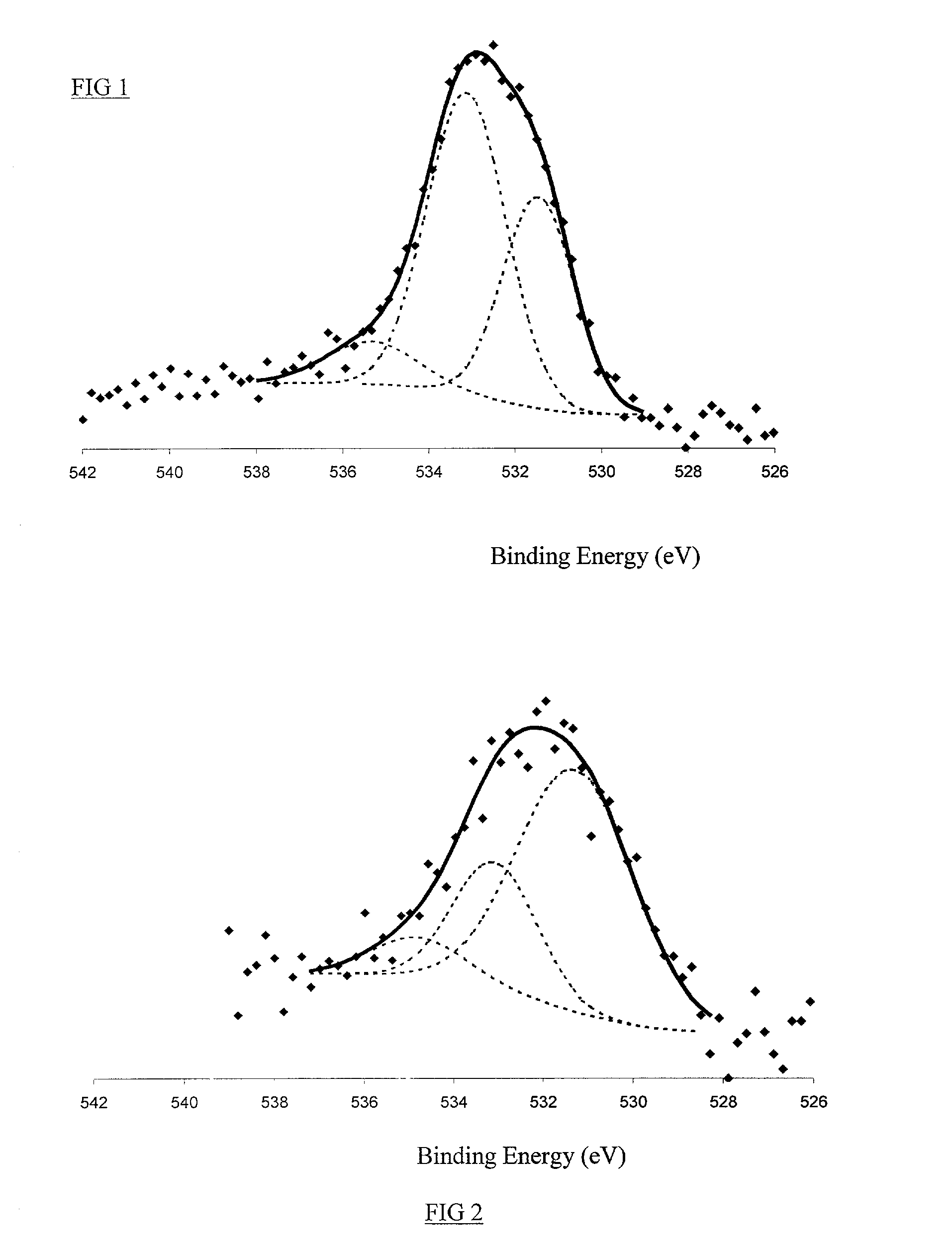Modification of nanotubes oxidation with peroxygen compounds
a technology of peroxygen compound and nanotube, which is applied in the field of modification of nanotube oxidation with peroxygen compound, can solve the problems of poor prediction of nanofiber chemistry, and difficulty in dispersing mass
- Summary
- Abstract
- Description
- Claims
- Application Information
AI Technical Summary
Benefits of technology
Problems solved by technology
Method used
Image
Examples
example 1
[0143] Aggregates of carbon nanotubes having a cotton candy morphology as described in Moy et al, having a cotton candy morphology as described in Moy et al, U.S. Pat. No. 5,456,897 prepared by methods described in Moy et al., U.S. Pat. No. 6,143,689 were oxidized as described below.
[0144] Oxidation was carried out by stirring the nanotubes in 1M (NH.sub.4).sub.2S.sub.2O.sub.8 / 1M H.sub.2SO.sub.4 solution for time periods of one to seven days at room temperature. The 1M (NH.sub.4).sub.2S.sub.2O.sub.81 / 1M H.sub.2SO.sub.4 solution was prepared by dissolving (NH.sub.4)S.sub.2O.sub.8 (Aldrich) in 1M H.sub.2SO.sub.4. Concentrations of nanotubes ranging from 3.247 g to 15 g in 300 cc 1M (NH.sub.4)S.sub.2O.sub.8 / 1M H.sub.2SO.sub.4 solution were used. Thick nanotube slurrys were formed during oxidation. The slurry was filtered, washed and dried to yield oxidized nanotubes. Determinations were made of the concentration of acidic groups on the surface of the treated nanotubes. The results are ...
example 2
[0147] The nanotubes described in Example 1 were oxidized as described below.
[0148] Oxidation was carried out with 0.5M (NH.sub.4)S.sub.2O.sub.8. Reaction conditions and the properties of the oxidized nanotubes are summarized in Table 2 below:
3TABLE 2 Weight Surface group Sample Oxidation Condition Change (meq / g) 1. 300 cc 0.5 M (NH.sub.4).sub.2S.sub.2O.sub.8 / 1 M + 0.48 H.sub.2SO.sub.4 7.513 g CC nanotubes, RT, 1 day 2. 300 cc 0.5 M (NH.sub.4).sub.2S.sub.2O.sub.8 / 1 M + 0.68 H.sub.2SO.sub.4 7.492 g CC nanotubes, RT, 2 days
[0149] A change of concentration of (NH.sub.4).sub.2S.sub.2O.sub.8 from 1 M to 0.5M only slightly affected the results of the oxidation. An acidic group concentration of 0.68 meq / g was titrated from the product prepared with 0.5 m (NH.sub.4).sub.2S.sub.2O.sub.8 / 1M H.sub.2SO.sub.4, compared to a value of 0.76 meq / g for a sample prepared with 1 M (NH.sub.4).sub.2S.sub.2O.sub.8 / 1M H.sub.2SO.sub.4.
example 3
[0150] 0.3 g of oxidized CC nanotubes (Sample 2 of Example 1) were added to 300 cc of water in a beaker. 5 drops of surfactant (Triton X-100, from Sigma) were added. The mixture was sonicated for 5 minutes with a 400 W ultrasonic processor to disperse the nanotubes. A mat with a diameter of 3.3" was prepared by filtration of the dispersion with a three-piece glass filtration assembly using a polyvinylidene fluoride (PVDF) membrane. After drying at 100.degree. C., the mat was heated at 350.degree. C. in air for 4 hr. The final weight of the mat was 283 mg. The thickness of the mat was 0.0049 inches. The density of the mat was 0.41 / cc.
PUM
| Property | Measurement | Unit |
|---|---|---|
| diameter | aaaaa | aaaaa |
| diameter | aaaaa | aaaaa |
| length | aaaaa | aaaaa |
Abstract
Description
Claims
Application Information
 Login to View More
Login to View More - R&D
- Intellectual Property
- Life Sciences
- Materials
- Tech Scout
- Unparalleled Data Quality
- Higher Quality Content
- 60% Fewer Hallucinations
Browse by: Latest US Patents, China's latest patents, Technical Efficacy Thesaurus, Application Domain, Technology Topic, Popular Technical Reports.
© 2025 PatSnap. All rights reserved.Legal|Privacy policy|Modern Slavery Act Transparency Statement|Sitemap|About US| Contact US: help@patsnap.com

